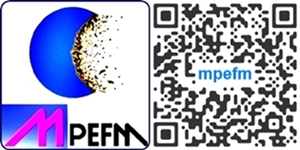"Big Country: Paintings of the Road Less Traveled"
Edie Nadelhaft

Lyons Wier Gallery
542 West 24th Street New York, NY 10011T: +1 212 242 6220 e-mail:
January 5 > 28, 2017
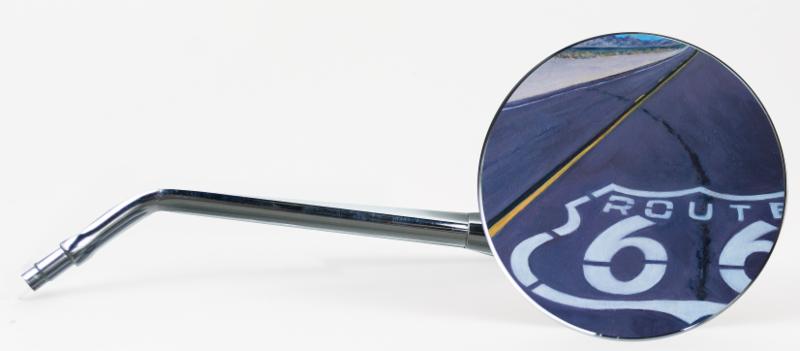 Route 66 (Amboy, CA), 2017, Oil on panel, Triumph America mirror housing, 4.5 x 13 x 2 inches |
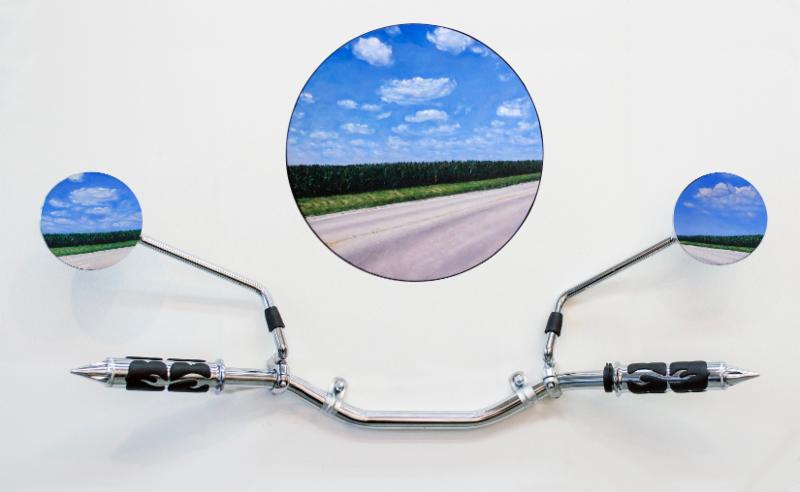 Somewhere in Illinois (triptych), 2017, Oil on panel, Harley Davidson mirror housing 33.5 x 30 x 5 inches (installation) |
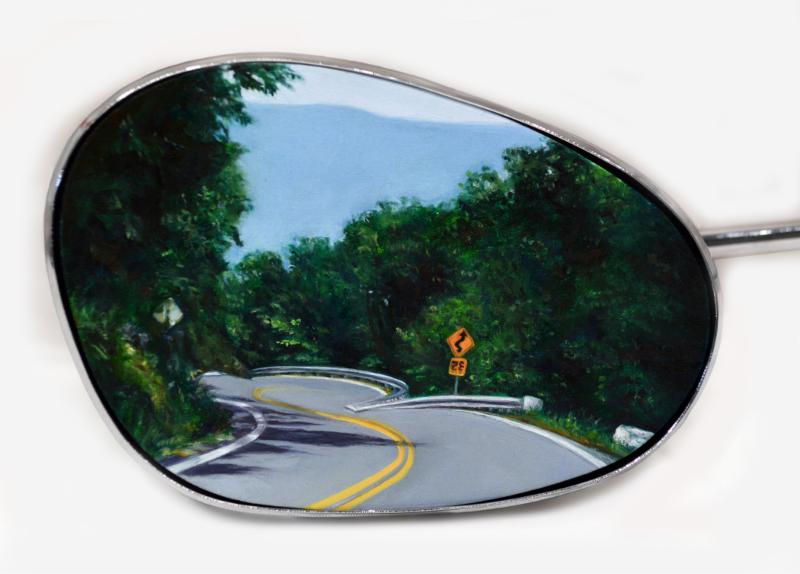 Blue Ridge Parkway (Near Gatlinburg), detail, 2017, Oil on panel, Bumm mirror housing, 3.5 x 5.5 inches (panel) |
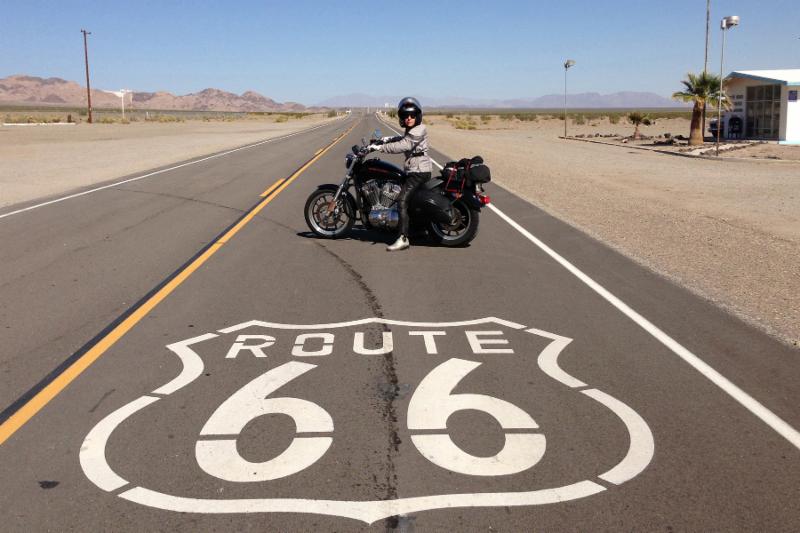 Artist Edie Nadelhaft on her motorcycle in Amboy, CA. Photo credit: Ron Raymond |
"America is not a place, it is a road."
-
Mark Twain
[New York] Big Country: Paintings of The Road Less Traveled is a show of new works by Edie Nadelhaft based on imagery glimpsed in her rear view mirrors as she navigates North America by motorcycle. Created to scale and situated within actual motorcycle mirror housings, these paintings are literal scenes from a road trip -- historically, the quin tessential American rite of passage. The exhibition title references the late artist Edward Avedisian's description of America: "It's a big country, and the only thing keeping it toge ther is television." Whether or not this was uttered in jest, Ms. Nadelha ft has seen the sentiment borne out in earnest on journeys that lead her away from her typical social and cultural experiences and out of her comfort zone. In an effort to avoid "the slab", as the Interstate is k nown in motorcycle - speak, Ms. Nadelhaft seek s out back roads and scenic byways, visiting places along the way that have yet to be subsumed by big box stores and global chain restaurants. The reward is a front row seat on a very different America, one rife with odd and often charming, if somewhat sha bby idiosyncrasies, many of which appear in the work. Unlike Ms. Nadelhaft's previous work, these paintings include a clear, if subtle narrative. Each piece includes some residue of a human presence (a sign, a road, a building). The slick, hard - edged beaut y of these man - made elements strikes a sharp contrast to the lush, raw landscape in which they appear.
A less obvious aspect of the work questions its very basis -- do we still want, or perhaps more importantly, do we still need road trips in the digital age? Driving, and especially motorcycling, has long been viewed as synonymous with the freedom, rebellion and self - expression embedded in our national psyche. But recent technological advances now undermine this convention. An unintended consequence o f ubi quitous personal computing is a historic decline in the number of teenagers pursuing that most coveted symbol of emancipation : a driver's license. The rise of digital culture has rendered the physical distribution of people and goods less urgent at the v er y least, if not completely unnecessary. People are no longer isolated socially or professionally by geography because many jobs can be done r emotely; texts and chat take the place of face - to - face personal contact. And when there is no sense of place, perso nal space and time is less clearly delineated.
More to the point, one doesn't actually have to travel to see anything anymore. Motorcycling offers a means of embedding ones elf within the physical landscape - to a much greater degree than a car trip. The re ar view becomes a metaphor for the decline of this type of activity. First - hand physical experience of the actual world is literally receding into the past. In such a time, it is both refreshing and s trange to get on the road and just ride. Clearly Ms. Nad elhaft is not alone. From Rain Man to Burning Man, the road trip continues to feature prominently in the American imagination.
"To date, I have ridden in 33 of the lower 48 states, as well as Nova Scotia, Pri n ce Edward Island, New Brunswick and Quebec. T he vastness of this continent is unmistakable. The climate and geographical diversity alone is stunning. When I read Avedisian's comment in 2013, I laughed out loud. But if I thought it was funny then, the poignancy of the remark couldn't be any clearer no w in the harsh light of our recent presidential election. For better or worse, it remains my BIG, (beautiful, messy), COUNTRY." - Edie Nadelhaft.
Edie Nadelhaft studied painting and art history at S.U.N.Y Purchase, New York and the School of the Museum o f Fine Art s in Boston, MA. She received her BFA with honors from Massachussetts College of Art, Boston, MA. Edie has exhibited extensively across the Un ited States, including the Provincetown Art Association Museum, Provincetown, MA, Fort Wayne Museum of A rt, Fort Wayne, IN, Naples Museum of Art, Naples, FL, C helsea Art Museum, New York, NY and Texas Contemporary, Houston, TX. She has completed artist residencies at the Gary & Melissa Oakland Studio, Visible Vault, Yellowstone Art Museum, Billings, MT, and Platte Clove Artist - In - Residency, Catskill Center for Conservation & Development, Catskill, NY. Edie Nadelhaft lives and works in New York City, NY
[New York] Big Country: Paintings of The Road Less Traveled is a show of new works by Edie Nadelhaft based on imagery glimpsed in her rear view mirrors as she navigates North America by motorcycle. Created to scale and situated within actual motorcycle mirror housings, these paintings are literal scenes from a road trip -- historically, the quin tessential American rite of passage. The exhibition title references the late artist Edward Avedisian's description of America: "It's a big country, and the only thing keeping it toge ther is television." Whether or not this was uttered in jest, Ms. Nadelha ft has seen the sentiment borne out in earnest on journeys that lead her away from her typical social and cultural experiences and out of her comfort zone. In an effort to avoid "the slab", as the Interstate is k nown in motorcycle - speak, Ms. Nadelhaft seek s out back roads and scenic byways, visiting places along the way that have yet to be subsumed by big box stores and global chain restaurants. The reward is a front row seat on a very different America, one rife with odd and often charming, if somewhat sha bby idiosyncrasies, many of which appear in the work. Unlike Ms. Nadelhaft's previous work, these paintings include a clear, if subtle narrative. Each piece includes some residue of a human presence (a sign, a road, a building). The slick, hard - edged beaut y of these man - made elements strikes a sharp contrast to the lush, raw landscape in which they appear.
A less obvious aspect of the work questions its very basis -- do we still want, or perhaps more importantly, do we still need road trips in the digital age? Driving, and especially motorcycling, has long been viewed as synonymous with the freedom, rebellion and self - expression embedded in our national psyche. But recent technological advances now undermine this convention. An unintended consequence o f ubi quitous personal computing is a historic decline in the number of teenagers pursuing that most coveted symbol of emancipation : a driver's license. The rise of digital culture has rendered the physical distribution of people and goods less urgent at the v er y least, if not completely unnecessary. People are no longer isolated socially or professionally by geography because many jobs can be done r emotely; texts and chat take the place of face - to - face personal contact. And when there is no sense of place, perso nal space and time is less clearly delineated.
More to the point, one doesn't actually have to travel to see anything anymore. Motorcycling offers a means of embedding ones elf within the physical landscape - to a much greater degree than a car trip. The re ar view becomes a metaphor for the decline of this type of activity. First - hand physical experience of the actual world is literally receding into the past. In such a time, it is both refreshing and s trange to get on the road and just ride. Clearly Ms. Nad elhaft is not alone. From Rain Man to Burning Man, the road trip continues to feature prominently in the American imagination.
"To date, I have ridden in 33 of the lower 48 states, as well as Nova Scotia, Pri n ce Edward Island, New Brunswick and Quebec. T he vastness of this continent is unmistakable. The climate and geographical diversity alone is stunning. When I read Avedisian's comment in 2013, I laughed out loud. But if I thought it was funny then, the poignancy of the remark couldn't be any clearer no w in the harsh light of our recent presidential election. For better or worse, it remains my BIG, (beautiful, messy), COUNTRY." - Edie Nadelhaft.
Edie Nadelhaft studied painting and art history at S.U.N.Y Purchase, New York and the School of the Museum o f Fine Art s in Boston, MA. She received her BFA with honors from Massachussetts College of Art, Boston, MA. Edie has exhibited extensively across the Un ited States, including the Provincetown Art Association Museum, Provincetown, MA, Fort Wayne Museum of A rt, Fort Wayne, IN, Naples Museum of Art, Naples, FL, C helsea Art Museum, New York, NY and Texas Contemporary, Houston, TX. She has completed artist residencies at the Gary & Melissa Oakland Studio, Visible Vault, Yellowstone Art Museum, Billings, MT, and Platte Clove Artist - In - Residency, Catskill Center for Conservation & Development, Catskill, NY. Edie Nadelhaft lives and works in New York City, NY




Opening Reception :
Thursday, January 5th, 6-8pm








